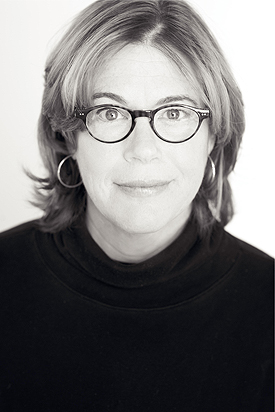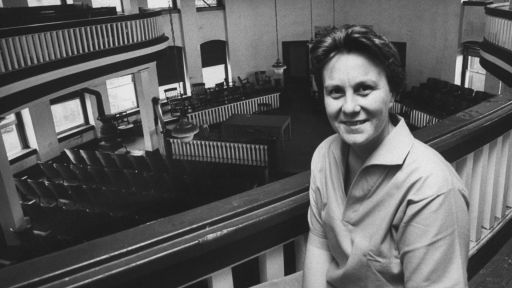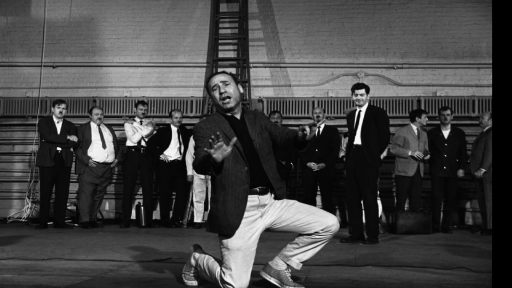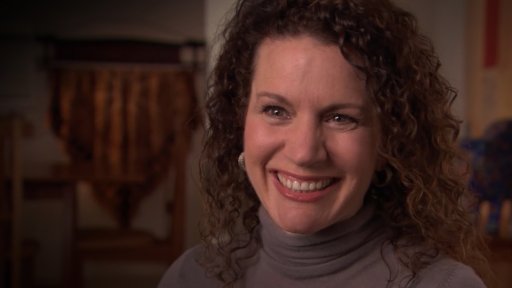Interview re-published compliments of Mary Murphy and Harper Perennial.
What gave you the idea for your book [Scout, Atticus, and Boo]?

Director Mary Murphy. Photo by Chris Carroll.
This all started as a documentary. When I was a producer at CBS News, I suggested stories about To Kill a Mockingbird but they were always turned down. My bosses would say, “No interview with Harper Lee, no news.” I read the novel again after I started my own production company. Freed of the demand for news, I thought about it differently. The novel was the story, not the novelist. How the novel came to be, its impact, influence, and enduring popularity—all that was a phenomenon well worth exploring. I started researching, reporting, and setting up interviews. By the time I cut twenty minutes of what was to become my documentary Hey, Boo: Harper Lee & To Kill a Mockingbird, I knew I had too much great material that would never make it onto the screen. I wanted to make the entire interviews available; hence the book.
What was the most surprising thing you learned from the interviews?
What I found most surprising was not one specific thing but how wonderfully wideranging all the responses were, whether it was Reverend Thomas Lane Butts, once the pastor of Harper Lee’s church in Monroeville, Alabama, saying the novel gave him comfort when he was organizing a bus boycott and confronting the Ku Klux Klan in Montgomery, Alabama, or Oprah Winfrey saying it was the first book she encouraged other people to read—in other words, her earliest book club selection. There seems to be an unlimited supply of fresh commentary about To Kill a Mockingbird. Every time the camera rolled, I heard something I had not heard before. This continued when I visited schools, libraries, bookstores, and film festivals after my book was published and the documentary released. Readers of all ages were eager to talk about To Kill a Mockingbird and share their own experience. This was true in schools from Upper Arlington High School in Columbus, Ohio, to the Academy of the Sacred Heart in New Orleans. It happened at libraries in Waterford, Connecticut, to Steamboat Springs, Colorado; in bookstores from Partners in Westport, Massachusetts, to BookPeople in Austin, Texas. And it was the case at film festivals from Sidewalk Film Festival in Birmingham, Alabama, to the Big Sky Film Festival in Missoula, Montana. I think this explains why the novel endures to this day. It has something for everyone, something meaningful and memorable.
How did you decide on the interview subjects?
Some of them had already written about To Kill a Mockingbird, like Wally Lamb and Scott Turow. Both are bestselling novelists and have the added perspectives of being a teacher (Lamb) and defense lawyer (Turow), so I approached them early on. I read historian Diane McWhorter’s Pulitzer Prize–winning book, Carry Me Home: Birmingham, Alabama: The Climactic Battle of the Civil Rights Revolution, and knew she would provide historical context and had a personal story to tell about her connection to the film. I wanted to speak to a civil rights leader, and Andrew Young agreed. In some cases I had a hunch. I read the memoirs of James McBride and Rick Bragg and thought I saw To Kill a Mockingbird’s influence on their work.
Some interviews were the result of sheer serendipity. I was at a book convention to interview novelists Lee Smith and Allan Gurganus and ran into Little, Brown publisher Michael Pietsch. When I told him about my project and asked if he had any authors I should talk to, Pietsch pointed me to Mark Childress, who was born in Monroeville, Alabama, Harper Lee’s hometown. I did a lengthy interview with Childress the same day. He was especially eloquent about how the novel helped to fuel the civil rights movement and gave white Southerners a way to question the system. Childress also had corresponded with Harper Lee herself and told me about it. He is a great presence in the documentary and it was my good luck to be able to include him.
Were the interviews difficult to get?
It is a testament to the novel that most of the writers I approached were only too happy to talk about its influence. They were easy to schedule and generous with their time. The people closest to Harper Lee were the hardest. The novelist’s older sister, Alice Finch Lee, and her close friends Michael and Joy Brown, the couple who aided her financially so that she might quit her job and write full-time, have up until now declined to give full interviews. It is a point of pride for me that they decided to answer my questions.
In both cases, it took time. After a few letters and a viewing of a rough cut of the documentary, Miss Alice agreed to see me. We had a delightful visit in her law office in Monroeville. Miss Alice tutored me in Alabama history, politics, soil, family history, and the Mitford sisters, among other things. Then she allowed me to return with a camera crew. When I interviewed her, Miss Alice was ninety-eight. She is deaf and on-camera questioning presented challenges. Miss Alice needed to be able to see my lips up close. You cannot see it onscreen but there were only about twelve inches of space between my face and hers.
The interview went on for five hours and Miss Alice never flagged. She is a remarkable person and, quite apart from her talented younger sister, she is a role model who has made a little history herself. One of the first women to be admitted to the bar in Alabama, Miss Alice is the oldest practicing attorney in the state. She has been a great mentor and support to women who want to become lawyers, including Tonja Carter, now one of her partners at Barnett, Bugg, Lee & Carter. Miss Alice also has held many posts within the United Methodist Church. Like anyone her age she has ailments and health issues, but does not complain. Miss Alice has a sharp memory and a good sense of humor, and enjoys keeping up with news, especially splashy murder and criminal trials. It has been a privilege to be in her company and I visit her as often as I can.
It was a privilege to interview Joy and Michael Brown. They are Harper Lee’s closest friends in New York City, and if not for their generosity at Christmas in 1956, giving her a year off from working for what was then known as the British Overseas Airways Company so that she might write full-time, To Kill a Mockingbird might never have happened. The Browns agreed to talk to me after my book went to the printers, and so their interviews appear only in the documentary.
Harper Lee wrote about the couple in an affectionate essay for McCall’s magazine, but she never named them: “They were a handsome pair, healthy in mind and body, happy in their extremely active lives. Common interests as well as love drew me to them: and an endless flow of reading material circulated amongst us; we took pleasure in the same theater, films, music, and we laughed at the same things, and we laughed so much in those days.”
Lee met Michael Brown first. A native of Mexia, Texas, Brown moved to New York after returning from overseas at the end of World War II and worked at temp jobs while finding his way as a composer/lyricist. Through a family friend, he met Truman Capote. “We got along very well,” Brown told me. “I thought he was phenomenal. I’d never met anyone quite like that. And his writing really amazed me.”
Brown and Capote stayed in touch. And out of the blue one day came a letter from Tangiers, where Capote was visiting the photographer Cecil Beaton. In his tiny handwriting, Capote said he had a shy friend from Monroeville, Alabama, who was moving to New York. Her name was Nelle Harper Lee. Would Brown kindly look after her? “Had she been a dreadful person, out of comradeship with Truman I still would have looked after her as best I could,” Brown said. And dreadful she was not. Brown, who is ninety now, with receding white hair and dancing hazel eyes, happily remembers meeting her at the Park Avenue apartment of Capote’s mother and stepfather: “Nelle and I were instant friends. Looking back on it, I can see why. We both came from small Southern towns; we both read books at an early age; we both loved New York. So here we were with similar backgrounds, blending Scotch, Irish, and English tribes. We had been brought up under parallel circumstances. Because of the death of my mother, my ten-years-older sister had taken care of me, while Nelle, too, had an older sister who took charge of her. Our respective fathers were gods to us, hers a lawyer, mine a doctor, and they were wonderful gods, indeed.”
Brown would soon abandon working as a typist for Billboard magazine to become a successful performer of his own words and music at New York’s most prestigious supper club, Le Ruban Bleu, where in his very first engagement he broke the house record with a run of fifty-four weeks. What made him different as an entertainer was that as often as not, his work was satiric, depicting such disparate real-life luminaries as Judge Crater, Lola Montez, and Tammy Faye Baker. “Lizzie Borden” was his first nationally known hit, followed by “The John Birch Society,” which later morphed into “The George Bush Society” to the same melody. Brown, it turned out, also was destined to have a literary success of his own. His children’s stories about Santa Mouse first appeared in 1966 and have remained popular every Christmas season since then.
In due course Michael met Joy Williams, a beautiful graduate of George Balanchine’s School of American Ballet. Balanchine subsequently brought Joy into the Ballet Russe de Monte Carlo. Later she joined Roland Petit’s Les Ballets de Paris as a principal dancer and met Margot Fonteyn, with whom she remained close friends for the next forty years.
Michael and Joy married, lived in a brownstone house on the east side of Manhattan, and had three boys, Michael, Kelly, and Adam. Lee was an intimate friend of the whole family and became an integral part of it. “We thought back then that Nelle Harper essentially was a writer,” said Joy Brown, who at eighty-three is a striking figure with a ballerina’s carriage, hair swept up around her head, and pale blue eyes. “She was not going to spend her life working as an airlines clerk while hoping to become something else.”
Lee shared some of her writing with her friends. “We read character sketches that she wrote about people in Monroeville,” said Michael. “And they were unusually perceptive. How could two people like Truman and Nelle be such close friends as children and grow up to see things the rest of us couldn’t envision? She just amazed us.”
In the fall of 1956, the Browns had a financial windfall when Michael created a show for an Esquire magazine presentation and the couple decided they could afford a special Christmas present for their friend. “I thought, here we have this bit of money, so why don’t we see if Nelle Harper could take some time off?” Joy remembered.
The rest, as we now know, is history. “Of course it tickled me,” Joy said. “They were going to publish five thousand copies, for Heaven’s sake!” At Lee’s insistence, the present became a loan and was paid back in full long ago. “At a time when we really needed the money,” Michael stressed. The Browns, who have never spoken publicly about their gift, would never dream of saying how much it was. The couple’s humility is plain to see. “We are not responsible for what occurred,” Michael said emphatically. “She was a writer to the depths of her soul. It would have happened with or without us. All that we did was hurry it up a little.”
The three friends remain as close as ever. When they talk, they do not spend a lot of time marveling about what happened, but it does come up. A few years ago, Miss Lee and Mr. Brown made a quiet trip to the New York Public Library so that Lee could look something up in Capote’s papers. They took a bus; children of the Depression do not take taxis. Returning from the library, as they walked along Forty-second Street in the anonymity of pedestrians, Brown remembered Lee’s speaking in genuine wonderment at the book’s phenomenal success. After all those years, it had still not quite sunk in.
Did you get to meet Harper Lee?
Harper Lee has famously scrawled “Hell, no” on the top of interview requests and sent them back, so I was not expecting much. Her literary agent turned down all my requests. There are many questions I would love to ask. But short of her telling me what’s what, I do think her sister and the Browns have added a great deal to the record. They bring new facts, anecdotes, and history. They have shared Harper Lee’s thinking and given us new insight into the writing process, why the novelist stopped speaking publicly, and why no second novel was forthcoming.
What has been the reaction to Scout, Atticus, and Boo?
When I set out to make a film and write a book about To Kill a Mockingbird, I knew high school English teachers would be a part of the audience but I didn’t know just how enthusiastic they would be. To Kill a Mockingbird was never assigned to me in high school and maybe that is why I became a student of it later in life. As a teenager, I may have missed the chance to savor the novel with the help of a teacher, but I am more than making up for it now. No one knows more about why Harper Lee’s first and only novel remains so popular than the teachers who teach it. They are a big part of the reason.
I showed an excerpt of the documentary and gave a talk at the 2010 convention of the National Council of Teachers of English, and the appreciative response was overwhelming. That led to many speaking engagements at schools across the country. It has been a tremendous experience.






















